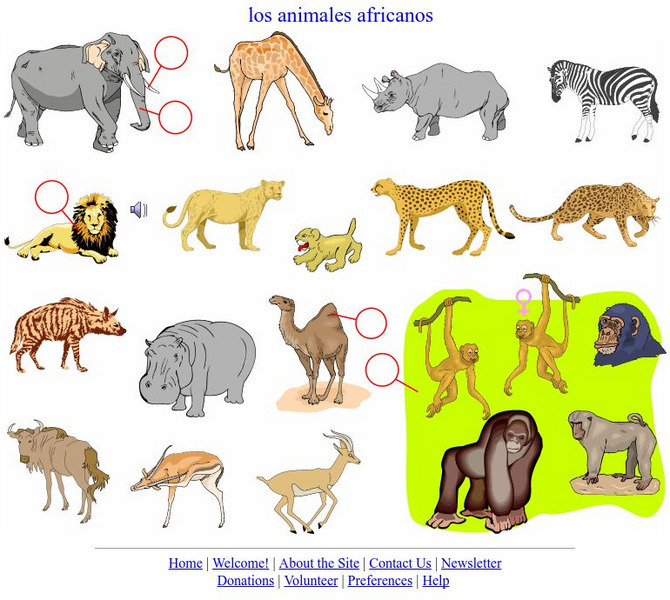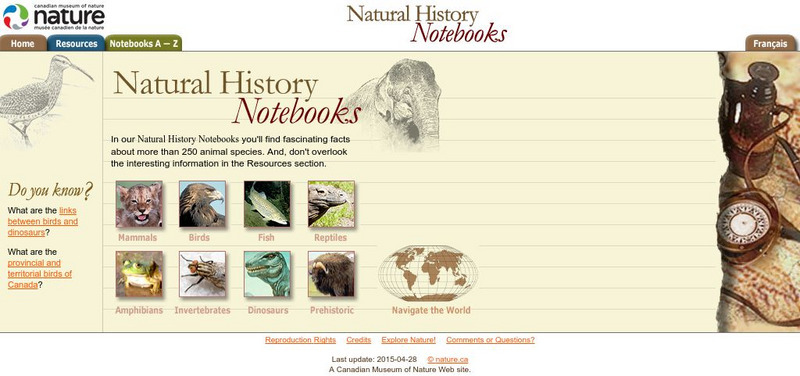Ducksters
Ducksters: Elephants for Kids: Learn About the Biggest Land Animal.
Why do Elephants have big ears, trunks, tusks? Kids learn about elephants, the endangered giants of India and Africa
Language Guide
Language Guide: Los Animales Africanos
Lots of colorful pictures illustrate African animals. Students can learn correct spelling and pronunciation by moving their mouse over each picture. Some pictures include the sound the animal makes, the name of the sound and the verb....
Curated OER
Baby Elephants
Use this site to get the facts on elephants with this elephant information page from the World Wildlife Fund. Content includes information on two different species of elephant, the African Elephant and the Asian Elephant. This is a site...
Science4Fun
Science4 Fun: Elephant
Learn about the appearance, diet, habitat, conservation, and other fun facts about this large land mammal.
Read Works
Read Works: Look Who's Talking
[Free Registration/Login Required] Students read about how elephants communicate with each other. A question sheet is available to help students build skills in cause and effect.
Curated OER
Elephant
Use this site to get the facts on elephants with this elephant information page from the World Wildlife Fund. Content includes information on two different species of elephant, the African Elephant and the Asian Elephant. This is a site...
Curated OER
Elephant Tusks
Use this site to get the facts on elephants with this elephant information page from the World Wildlife Fund. Content includes information on two different species of elephant, the African Elephant and the Asian Elephant. This is a site...
Curated OER
Elephant Tusks
Use this site to get the facts on elephants with this elephant information page from the World Wildlife Fund. Content includes information on two different species of elephant, the African Elephant and the Asian Elephant. This is a site...
Curated OER
Elephant Tusks
Use this site to get the facts on elephants with this elephant information page from the World Wildlife Fund. Content includes information on two different species of elephant, the African Elephant and the Asian Elephant. This is a site...
Curated OER
Elephant Tusks
Use this site to get the facts on elephants with this elephant information page from the World Wildlife Fund. Content includes information on two different species of elephant, the African Elephant and the Asian Elephant. This is a site...
Other
Barnum Museum
This website gives information on P.T. Barnum himself and special exhibits like Jumbo, the African elephant, and Tom Thumb.
PBS
Pbs Learning Media: Squatter's Rights
Protecting their farms from elephants is a daily fight for African farmers in the Sahel. In this video segment from Africa, learn about the relationship between the African farmers and elephants in the Sahel.
San Diego Zoo Global
San Diego Zoo: Animals
This resource describes the most popular animals at the world-famous San Diego Zoo. Each profile gives background about a specific animal, and more information about the species.
National Geographic
National Geographic: Gis in Action
Use maps to solve problems and help animals. Click on an animal to learn important facts, then click on the map to see layers of different kinds of information.
Museums Victoria
Melbourne Museum: Meet the Skeletons: Quetzalcoatlus Northropi
Quetzalcoatlus northropi was a carnivorous pterosaur larger than an African elephant. It lived during the Cretaceous Period. Some information and pictures can be found here.
Curated OER
Bbc Nature: Wildlife: Rufous Elephant Shrew
Close-up image of the rufous elephant shrew, an African mouse-like animal.
Canadian Museum of Nature
Canadian Museum of Nature: Natural History Notebooks
This site from the Canadian Museum of Nature, a natural history museum, provides short information blurbs and fun facts on over 240 different common animals categorized by type (mammals, fish, reptiles, invertebrates, amphibians,...
Smithsonian Institution
Smithsonian National Zoo
Here is the National Zoological Park right at our fingertips. Students will find many things to explore at this colorful and engaging site. Any study of animals will have a successful start here. Chances are students can catch their...
Missouri Botanical Garden
Missouri Botanical Garden: Grassland Animals
This site from the Evergreen Project of the Missouri Botanical Garden provides great information. Click on the animal link on the left. There is an introduction to animals in the grasslands, and then you can read more about each...
Missouri Botanical Garden
Missouri Botanical Garden: Grassland Animals
This site from the Missouri Botanical Garden provides animal descriptions of several grassland animals. Content includes pictures, fact sheets, and more.
Smithsonian Institution
National Museum of Natural History: American Mammals: Blue Whale
As far as we know, the blue whale is the largest animal ever to have existed on the planet. Weights up to 190,000 kg (as much as 30-40 African elephants) have been recorded. Learn more about the Balaenoptera musculus, more commonly known...
Houghton Mifflin Harcourt
Harcourt: School Publishers: Animal Communities
At this site click on the pictures to find out about an animal community in Africa. Think about how animal communities are like your community. Think about how are they different.
Other popular searches
- Asian and African Elephants
- Endangered African Elephants
- African Elephants Food Chain
- African Elephants in Art













